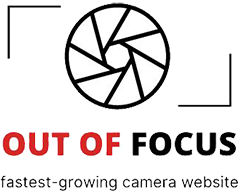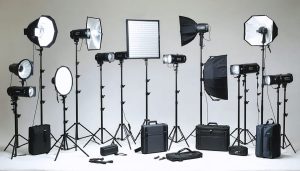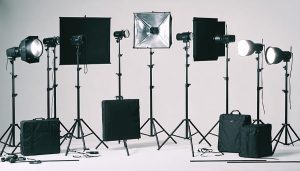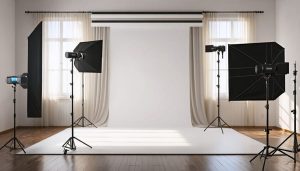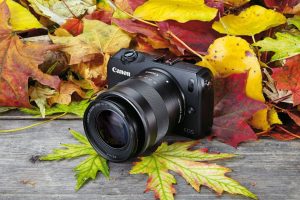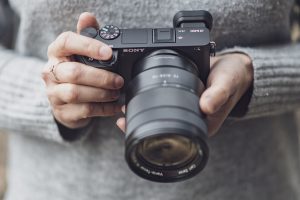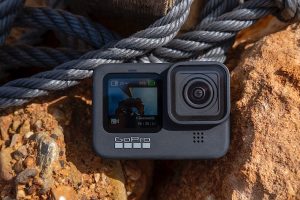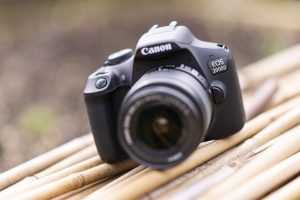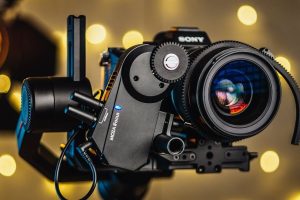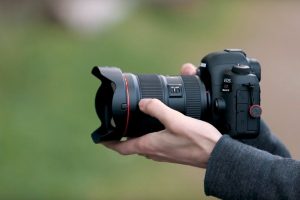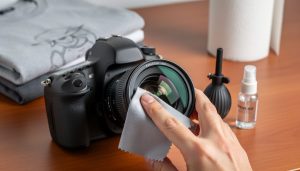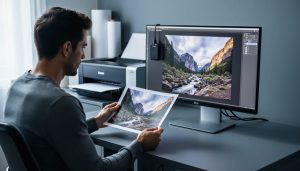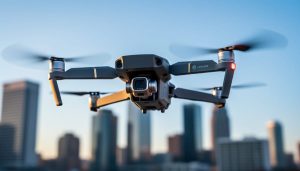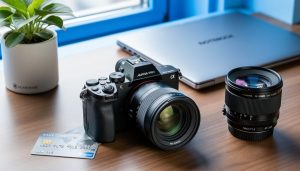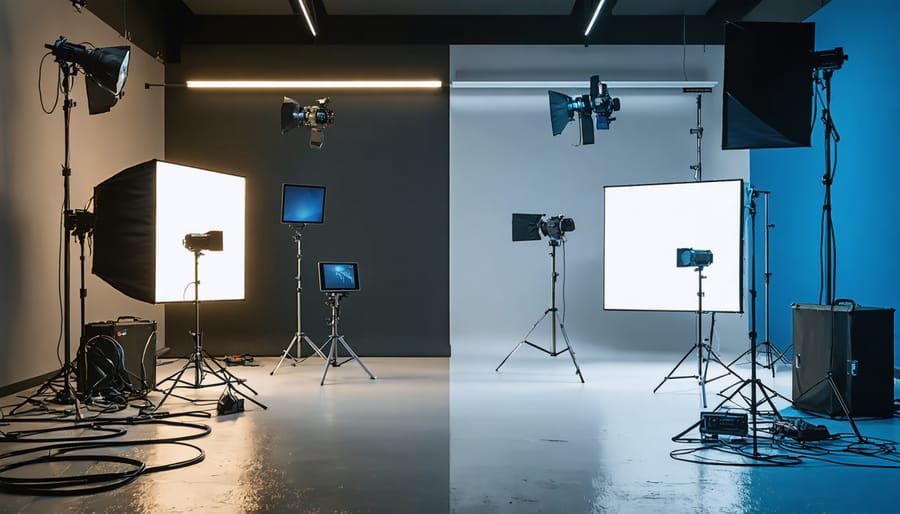
Transform your studio workflow instantly with wireless lighting control systems that put professional-grade illumination at your fingertips. These advanced photography lighting equipment solutions eliminate tangled cables, enable rapid adjustments from anywhere in the studio, and unlock creative possibilities previously hindered by traditional wired setups.
Modern wireless systems integrate seamlessly with multiple flash units, continuous lights, and ambient lighting controls, offering photographers unprecedented flexibility during shoots. Through smartphone apps or dedicated controllers, adjust power levels, color temperature, and firing sequences in real-time without interrupting your connection with subjects or compromising your shooting position.
Whether you’re orchestrating complex multi-light setups for commercial work or seeking efficient single-light control for portraits, wireless lighting control represents the intersection of technical innovation and creative freedom. This technology not only streamlines the physical aspects of lighting management but fundamentally changes how photographers interact with their lighting environment, enabling more dynamic and responsive shooting sessions.
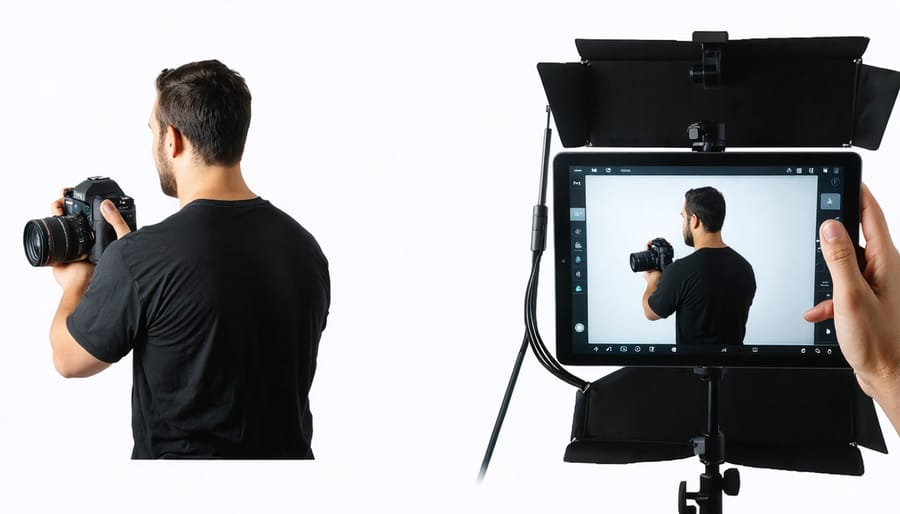
Why Wireless Lighting Control Matters in Photography
Real-Time Adjustments Without Breaking Flow
One of the most liberating aspects of wireless lighting control is the ability to make real-time adjustments without interrupting your creative flow. Imagine you’re photographing a portrait session, and you notice the key light needs a slight power adjustment. Instead of walking over to each light, breaking your connection with the subject, you can instantly modify settings from your camera position or control panel.
This seamless control allows photographers to maintain the crucial rapport with their subjects while fine-tuning their lighting setup. During fashion shoots or dynamic portrait sessions, you can smoothly transition between lighting scenarios, adjusting ratios and intensities on the fly as your subject moves or the creative direction evolves.
The immediate feedback loop is particularly valuable when working with time-sensitive situations. Wedding photographers can quickly adapt their lighting as the couple moves through different locations, while commercial photographers can efficiently experiment with various lighting combinations during limited studio time.
Many modern wireless systems also offer preset capabilities, allowing you to switch between carefully crafted lighting scenarios with a single tap, ensuring you never miss a decisive moment while adjusting your lights.
Multi-Light Setup Management
Managing multiple lights in a wireless setup becomes remarkably straightforward with modern control systems. Rather than running back and forth between different units, photographers can adjust multiple lights simultaneously from a central controller. This functionality is particularly valuable when working with complex lighting arrangements involving main lights, fill lights, hair lights, and background illumination.
Most wireless systems allow you to organize lights into groups, making it easy to control specific sets of lights while leaving others unchanged. For instance, you might group all your background lights together, enabling quick adjustments to maintain the perfect backdrop exposure while independently managing your key light setup.
Scene memory features let you save specific lighting configurations for quick recall. This proves invaluable when shooting different setups during the same session or when returning to previously successful lighting arrangements. Many systems also offer synchronization capabilities, ensuring all lights respond instantly to commands without noticeable delay.
For more complex shoots, advanced systems provide individual control over each light while maintaining the ability to adjust them collectively. This flexibility allows photographers to fine-tune their lighting with precision while maintaining efficient workflow management.
Core Components of Wireless Lighting Systems
Controllers and Interfaces
Modern wireless lighting control systems offer photographers multiple ways to command their lighting setup. Mobile apps have become increasingly popular, providing intuitive interfaces with real-time adjustments of power, modeling lights, and groups right from your smartphone or tablet. These apps often include advanced features like saving presets and creating custom lighting scenarios.
Dedicated remote controllers remain a reliable choice for many photographers, offering tactile buttons and instant response times. These purpose-built devices typically feature LCD screens displaying key information and allow quick adjustments even while looking through the viewfinder. Some advanced remotes include features like zone control and the ability to trigger multiple groups of lights independently.
Computer software provides the most comprehensive control options, particularly useful in tethered shooting scenarios. These programs often integrate with popular photo editing software and offer extensive customization options, detailed power control, and the ability to save complex lighting arrangements. Many manufacturers provide their own proprietary software, though third-party solutions are available for cross-brand compatibility.
Voice control is emerging as a convenient hands-free option, allowing photographers to adjust lighting while handling their camera or directing subjects. Some systems also offer wall-mounted panels for studio installations, combining the convenience of fixed controls with wireless functionality.
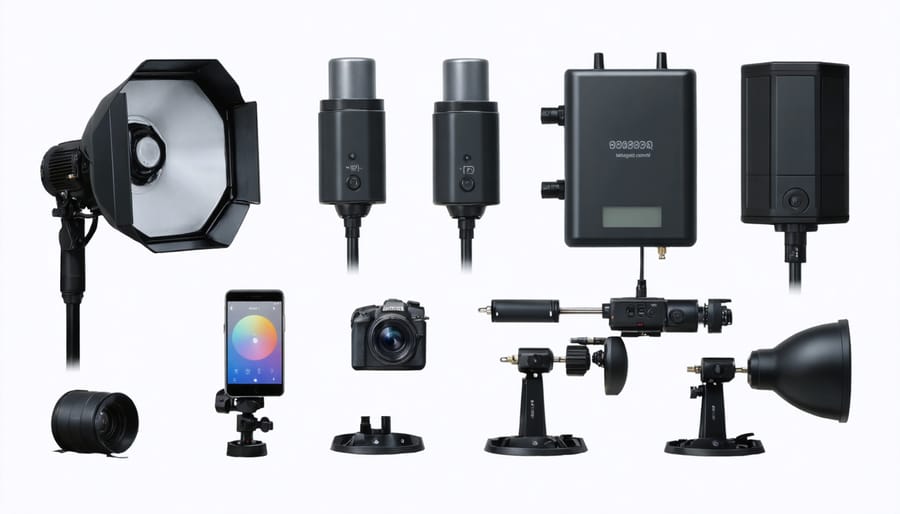
Compatible Light Types
Modern wireless lighting control systems are remarkably versatile, compatible with a wide range of lighting equipment commonly used in photography. Most systems work seamlessly with traditional speedlights, making them an excellent starting point for photographers new to wireless control. These compact flash units can be easily integrated into a wireless setup, whether you’re using them bare or with lighting modifiers.
Studio strobes and monolights are equally well-supported, with many manufacturers building wireless receivers directly into their professional lighting equipment. This integration eliminates the need for external receivers and simplifies setup. LED continuous lights have also joined the wireless revolution, with many modern panels offering full wireless control over brightness, color temperature, and even RGB effects.
The system’s compatibility extends to specialty lighting equipment like ring lights, strip lights, and even some architectural lighting fixtures. Many wireless controllers can manage multiple types of lights simultaneously, allowing photographers to mix and match different lighting tools based on their creative needs.
When selecting equipment, look for lights that support common wireless protocols like TTL, HSS (High-Speed Sync), and manual power control. Most current systems are backward compatible with older lighting equipment through add-on receivers, ensuring your existing gear isn’t obsolete when upgrading to wireless control.
Setting Up Your First Wireless Lighting System
Basic Configuration Steps
Setting up your wireless lighting control system doesn’t have to be complicated. Let’s walk through the essential steps to get your system up and running for an efficient studio lighting setup.
First, ensure all your lighting units have fresh batteries or are properly connected to power sources. Mount your lights on their respective stands and position them according to your planned layout. Next, attach the wireless receivers to each light unit, making sure they’re securely fastened and switched on.
Install the transmitter unit onto your camera’s hot shoe mount, or if you’re using a handheld controller, ensure it’s charged and ready. Most modern systems use automatic channel detection, but you may need to manually sync your transmitter and receivers. This typically involves pressing the sync button on both devices until their indicator lights match.
Access your transmitter’s menu system and assign each light to a separate group (usually labeled A, B, C, etc.). This organization allows you to control multiple lights independently. Set your initial power levels for each group – starting at around 1/4 power is often a good baseline.
Test the communication between your transmitter and receivers by adjusting power levels and triggering test flashes. Ensure all units respond correctly to your commands. If you encounter any issues, try repositioning the receivers for better line of sight or checking for potential interference sources.
Remember to save your preferred settings as a custom preset if your system offers this feature. This saves valuable time during future sessions and provides a reliable starting point for different shooting scenarios.
Common Setup Challenges
Setting up a wireless lighting control system can present several common challenges, but most are easily resolved with the right approach. One frequent issue is signal interference, which often occurs in spaces with multiple electronic devices or thick walls. To minimize this, try repositioning your transmitter and receivers or switching to a different frequency channel if your system allows it.
Pairing problems between devices are another typical hurdle. If your lights aren’t responding, start by ensuring all units are set to the same group or channel. Sometimes, simply power cycling both the transmitter and receivers can resolve stubborn connection issues. Remember to check that your batteries are fresh and properly installed, as low power can cause intermittent connectivity problems.
Range limitations can also pose challenges, especially in larger studios. While manufacturers often quote impressive maximum distances, real-world conditions like obstacles and interference can reduce effective range. Consider using repeaters or positioning your lights strategically to maintain reliable connections.
Some photographers encounter issues with flash sync timing, resulting in missed exposures or partial lighting. This usually stems from incorrect sync speed settings or compatibility mismatches between your camera and lighting system. Double-check your camera’s sync speed settings and ensure your trigger is fully compatible with your camera model.
Firmware mismatches between components can cause unexpected behavior. Keep all your devices updated with the latest firmware, but update them one at a time to avoid potential compatibility issues. If you’re experiencing persistent problems, try resetting all components to factory settings before reconfiguring your setup.
Remember that most wireless systems need line-of-sight between the transmitter and receivers for optimal performance. While they can often work through minor obstacles, maintaining clear paths between components will ensure the most reliable operation.
Advanced Techniques and Creative Applications
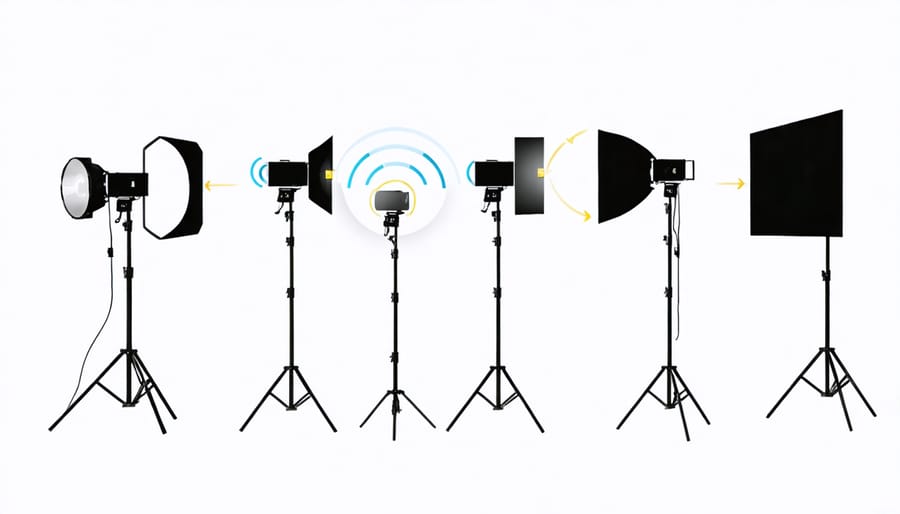
Scene Presets and Transitions
Scene presets are game-changers in wireless lighting control, allowing photographers to save and recall specific lighting configurations instantly. Think of them as lighting recipes that you can store and access at the touch of a button, making your professional lighting setup more efficient and consistent.
Most wireless lighting systems allow you to create multiple presets for different shooting scenarios. For instance, you might save one preset for high-key portraits with soft, wraparound lighting, another for dramatic fashion shots with strong side lighting, and a third for product photography with even illumination.
Transitions between presets can be programmed to occur smoothly over a specified duration, which is particularly useful for video work or when you need to gradually shift the mood during a shoot. Some advanced systems even allow you to create custom sequences, where lighting changes automatically progress through multiple presets.
To make the most of presets, consider organizing them into logical groups based on your typical shooting scenarios. For example:
– Portrait presets (beauty, corporate, environmental)
– Product presets (reflective, transparent, textured)
– Event presets (speeches, dance floor, ambient)
Remember to name your presets clearly and maintain a consistent naming convention. This simple organizational step can save precious time during busy shoots when quick lighting adjustments are needed.
Integration with Other Studio Equipment
Modern wireless lighting control systems excel at playing well with other studio equipment, creating a seamlessly integrated photography workspace. Many systems now feature DMX protocol compatibility, allowing them to sync with other DMX-enabled devices like fog machines, motorized backdrops, and even some camera triggers.
Most professional wireless controllers can integrate with popular studio management software, enabling photographers to save and recall lighting setups alongside camera settings and prop positions. This integration proves invaluable when recreating specific looks or maintaining consistency across multiple shooting sessions.
The latest systems also offer compatibility with mobile apps and tablet interfaces, which can display real-time previews of lighting effects and allow for quick adjustments during shoots. Some advanced controllers even integrate with color meters and light meters, automatically adjusting output to maintain perfect exposure and color temperature.
For video production, many wireless lighting systems now sync with video switchers and production controllers, enabling smooth transitions between lighting scenes. Some manufacturers have developed proprietary ecosystems where their lights, triggers, and modifiers all communicate seamlessly, though most still maintain compatibility with third-party equipment.
Remember to check compatibility specifications when mixing equipment from different manufacturers. While most modern systems are designed for interoperability, some features may only be available within the same brand ecosystem.
Wireless lighting control systems have revolutionized the way photographers work, bringing unprecedented flexibility and efficiency to both studio and location shoots. By eliminating the need for complex cable setups and enabling remote adjustments, these systems have transformed what was once a time-consuming technical process into a seamless creative endeavor.
The impact on workflow efficiency cannot be overstated. Photographers can now focus more on composition and connecting with their subjects rather than constantly walking back and forth to adjust lights. This enhanced workflow not only saves valuable time during shoots but also allows for more spontaneous creative decisions and experimentation with lighting setups.
The accessibility of wireless lighting control has also democratized advanced lighting techniques. What was once the domain of high-end studio photographers is now available to enthusiasts and emerging professionals. This technological advancement has raised the overall quality of photography across the industry, enabling photographers of all levels to achieve professional-looking results.
Looking ahead, wireless lighting control systems will continue to evolve, with improved reliability, greater range, and more sophisticated features. As these systems become more integrated with other photography tools and software, we can expect even more streamlined workflows and creative possibilities. For photographers willing to embrace this technology, wireless lighting control represents not just a convenient tool, but a fundamental shift in how we approach lighting in photography.
